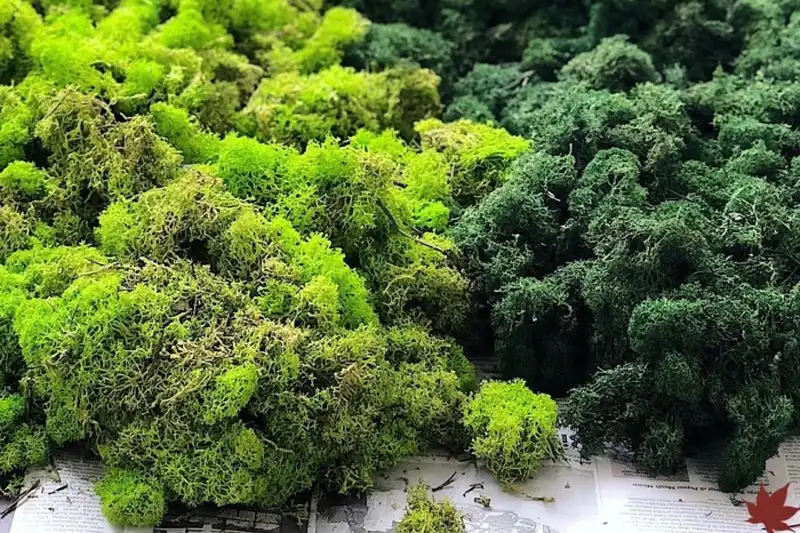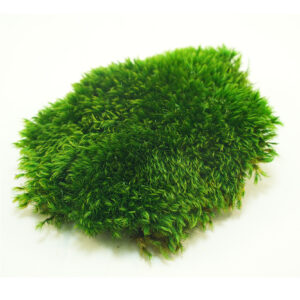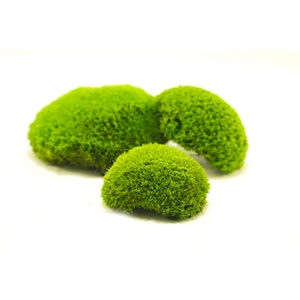Preserved moss refers to moss that has undergone a preservation process to maintain its natural appearance and texture while extending its lifespan. Moss is a type of small, non-vascular plant that typically grows in damp and shaded environments. Preserving moss allows it to be used for various decorative and landscaping purposes without requiring maintenance or access to specific growing conditions. Stay with BestMoss.
»»» Moss wall «««
Can preserved moss get wet?
Preserved moss is not designed to withstand prolonged exposure to water, and getting it wet can compromise its integrity. Preserved moss undergoes a preservation process that replaces the natural moisture within the plant with a solution. This process allows the moss to maintain its appearance and texture over an extended period without the need for watering.
Exposure to water can reverse the preservation process and lead to several issues, including:
Rehydration
Preserved moss may absorb water, leading to changes in color, texture, and overall appearance.
Leaching of Preservation Agents
Water exposure may cause the leaching of the preserving agents used during the preservation process. This can affect the stability of the moss.
Mold and Mildew
Moist conditions can promote the growth of mold and mildew on the preserved moss, leading to decay and an unpleasant appearance.
To ensure the longevity and visual appeal of preserved moss, it's essential to keep it dry and avoid any contact with water. When used in decorative installations such as moss walls or other interior designs, preserved moss should be placed in environments where it won't be exposed to water or excessive humidity.
If preserved moss accidentally gets wet, it's advisable to allow it to air-dry completely in a well-ventilated area. Avoid direct sunlight during the drying process, as excessive sunlight exposure can also impact the color of preserved moss.
Remember that the primary advantage of preserved moss is its low-maintenance nature, as it doesn't require watering or specific environmental conditions. Keeping it dry and away from water sources is crucial to preserving its aesthetic qualities over time.
««« Buy Preserved moss »»»
Does preserved moss clean air?
Preserved moss, unlike living plants, does not actively participate in air purification through processes like photosynthesis. Preserved moss has undergone a preservation treatment, typically involving the use of solutions, to maintain its appearance and texture without the need for water or soil. Additionally, preserved moss can help remove certain airborne pollutants and improve indoor air quality.
Keep in mind that the primary benefit of preserved moss is its ability to maintain its appearance without the need for water or specific growing conditions.
Is preserved moss toxic?
Preserved moss is generally considered non-toxic when used as intended for decorative and design purposes. The preservation process typically involves treating the moss with substances that are generally safe for handling.
However, it's essential to note that some individuals may have sensitivities or allergies to certain substances, including those used in the preservation process. As a general precaution:
Read Labels: Check product labels for information about the preservation process and any additional treatments.
Handle with Care: While preserved moss is generally safe, avoid prolonged contact with skin, especially if you have known sensitivities.
Keep Away from Pets and Children: Ensure that preserved moss and any decorative items made from it are kept out of reach of pets and small children who may be prone to exploring and putting things in their mouths.
Ventilation: If using preserved moss in enclosed spaces, ensure proper ventilation to minimize the inhalation of any particles that may be present.
If you have specific concerns or allergies, it's advisable to contact the manufacturer or supplier for detailed information about the preservation process and any potential allergens used in the production of preserved moss products.
Does preserved moss grow?
Preserved moss does not grow because the preservation process involves halting its natural biological functions. The preservation process typically replaces the natural moisture content of the moss with a solution, and stabilizing agents. This treatment helps the moss maintain its appearance, texture, and color over an extended period without the need for water or soil.
Preserved moss is essentially in a static state, and it will not exhibit growth, reproduction, or any of the dynamic processes associated with living plants. As a result, preserved moss retains its initial size and structure without undergoing changes commonly observed in living moss.
While preserved moss offers the advantage of requiring minimal maintenance and providing a long-lasting decorative element, it is essential to recognize that it lacks the living characteristics and functions associated with actively growing plants. If you are looking for moss that will continue to grow and change over time, you may want to consider live moss or other living plants for your indoor or outdoor greenery needs.
Does preserved moss attract bugs?
Preserved moss, when properly treated and preserved, is less likely to attract bugs compared to living plants. The preservation process typically involves treating the moss with solutions to stabilize it and prevent decay. This treatment helps make the moss less appealing to insects, as it lacks the nutrients and conditions that attract pests.
However, it's important to note that the attractiveness of preserved moss to bugs can depend on several factors:
Preservation Quality: High-quality preservation methods are more effective at deterring insects. Moss that has undergone thorough and professional preservation is less likely to attract bugs.
Additional Treatments: Some preserved moss products may have additional coatings or treatments that could influence their attractiveness to insects. Always check the product information for details on any added substances.
Environmental Conditions: The overall environment can play a role. Insects may be attracted to areas with high humidity, so it's crucial to maintain a dry environment for preserved moss.
Stored Conditions: If preserved moss is stored in areas prone to insect activity, there is a slight risk of attracting bugs. Proper storage in clean and sealed containers can help mitigate this risk.
While preserved moss is generally considered less attractive to bugs, it's advisable to monitor the environment and take preventive measures, especially if you notice any changes or suspect insect activity.
where to buy preserved moss?
Is preserved moss alive?
Preserved moss is not alive. The preservation process involves treating the moss with substances and stabilizing agents to replace the natural moisture within the plant. This process effectively halts the biological functions of the moss, including growth, reproduction, and metabolism.
While preserved moss retains its original appearance, color, and texture, it lacks the characteristics of living plants. It doesn't require water, soil, or sunlight to survive, and it won't undergo changes or growth over time. Preserved moss is essentially in a static state, maintaining its aesthetic qualities without the need for ongoing care.
The preservation process allows moss to be used for decorative purposes in various applications, such as moss walls and craft projects, without the maintenance requirements associated with living plants. The main advantage of preserved moss is its longevity and ability to maintain a consistent appearance over an extended period.
Can you use preserved moss in a terrarium?
Yes, preserved moss can be used in a terrarium for decorative purposes. Preserved moss offers the advantage of maintaining its appearance and texture without requiring the same care as living plants.
Is preserved moss toxic to cats?
Preserved moss, when used for decorative purposes, is generally considered non-toxic. However, it's important to note that some cats may be curious and may attempt to chew on or ingest decorative elements, including preserved moss.
The preservation process typically involves using substances, which is generally regarded as safe. Nevertheless, it's crucial to take precautions to ensure the safety of your pets. If your cat ingests a significant amount of preserved moss, it's advisable to contact your veterinarian for guidance.
Is preserved moss safe?
Preserved moss is generally considered safe for use in decorative applications when handled properly. The preservation process involves treating the moss with substances to replace its natural moisture, stabilizing its structure and maintaining its appearance over time.
Does preserved moss need sunlight?
Preserved moss does not require sunlight. Unlike living plants, preserved moss has undergone a preservation process that replaces its natural moisture with substances stabilizing its structure and allowing it to maintain its appearance without the need for sunlight or water.
Preserved moss is an ideal option for indoor spaces or areas with limited natural light, as it doesn't rely on photosynthesis for energy. Its primary advantage is its ability to thrive in environments where live plants might struggle due to low light conditions.
While preserved moss doesn't need sunlight, it's important to consider the specific lighting conditions of the space where you plan to use it. Prolonged exposure to direct sunlight can potentially impact the color of preserved moss over time, causing it to fade. Therefore, it's advisable to position preserved moss installations away from direct sunlight or use diffused lighting to maintain its appearance.
In summary, preserved moss is a versatile and low-maintenance option for decorative purposes, and it can thrive in environments without direct sunlight. Its ability to maintain a consistent and vibrant appearance makes it suitable for various indoor applications, such as moss walls and other design projects.




